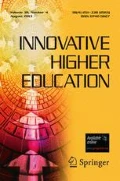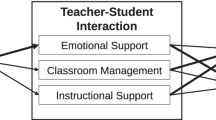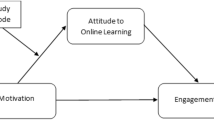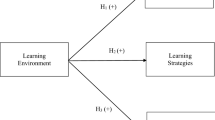Abstract
Developing student critical thinking skills is a core purpose of higher education, and requires the cognitive and disposition components of critical thinking to be fostered. The present study aims to examine the relationship between disposition towards critical thinking and engagement in higher education students. Participants were 836 students from two universities in Spain. Results showed a direct and positive relationship between student critical thinking disposition and several aspects of student engagement, such as reflective learning and participation in high-impact practices. These results could inform general pedagogical practices within the higher education curriculum so as to foster critical thinking disposition among future graduates.
Similar content being viewed by others
Data Availability
The data that support the findings of this study are available from the corresponding author, upon reasonable request.
References
Abrami, P. C., Bernard, R. M., Borokhovski, E., Waddington, D. I., Wade, C. A., & Persson, T. (2015). Strategies for teaching students to think critically: A meta-analysis. Review of Educational Research, 85(2), 275–314. https://doi.org/10.3102/0034654314551063
Agudo Saiz, D., Salcines Talledo, I., & González Fernández, N. (2020). Pensamiento crítico en ESO y Bachillerato: perspectiva de docentes y estudiantes de un IES en una provincia del norte de España. Tendencias Pedagógicas, 37, 121–133. https://doi.org/10.15366/tp2021.37.010.
Akpur, U. (2020). Critical, reflective, creative thinking and their reflections on academic achievement. Thinking Skills and Creativity, 37. https://doi.org/10.1016/j.tsc.2020.100683
Alsina, Á., Ayllón, S., Colomer, J., Fernández-Peña, R., Fullana, J., Pallisera, M., Pérez-Burriel, M., & Serra, L. (2017). Improving and evaluating reflective narratives: A rubric for higher education students. Teaching and Teacher Education, 63, 148–158. https://doi.org/10.1016/j.tate.2016.12.015
Alvarez-Huerta, P., Muela, A., & Larrea, I. (2021). Student engagement and creative confidence beliefs in higher education. Thinking Skills and Creativity. https://doi.org/10.1016/j.tsc.2021.100821
Álvarez-Huerta, P., Muela, A., & Larrea, I. (2022). Disposition toward critical thinking andcreative confidence beliefs in higher education students: The mediating role of openness to diversity and challenge. Thinking Skills and Creativity, 101003. https://doi.org/10.1016/j.tsc.2022.101003
Anaya, G. (1999). College impact on student learning: Comparing the use of self-reported gains, standardized test scores, and college grades. Research in Higher Education, 40(5), 499–526. https://doi.org/10.1023/A:1018744326915
Arend, B. (2009). Encouraging critical thinking in online threaded discussions. The Journal of Educators Online. https://files.eric.ed.gov/fulltext/EJ904064.pdf
Arslan, R., Gulveren, H., & Aydin, E. (2014). A research on critical thinking tendencies and factors that affect critical thinking of higher education students. International Journal of Business and Management, 9(5). https://doi.org/10.5539/ijbm.v9n5p43
Bakadorova, O., Lazarides, R., & Raufelder, D. (2020). Effects of social and individual school self-concepts on school engagement during adolescence. European Journal of Psychology of Education, 35(1), 73–91. https://doi.org/10.1007/s10212-019-00423-x
Bezanilla-Albisua, M. J., Poblete-Ruiz, M., Fernández-Nogueira, D., Arranz-Turnes, S., & Campo-Carrasco, L. (2018). El Pensamiento Crítico desde la Perspectiva de los Docentes Universitarios. Estudios Pedagógicos, 44(1), 89–113. https://doi.org/10.4067/s0718-07052018000100089
Bezanilla, M. J., Fernández-Nogueira, D., Poblete, M., & Galindo-Domínguez, H. (2019). Methodologies for teaching-learning critical thinking in higher education: The teacher’s view. Thinking Skills and Creativity, 33, 100584. https://doi.org/10.1016/j.tsc.2019.100584
Bezanilla, M. J., Galindo-Domínguez, H., & Poblete, M. (2021). Importance of teaching critical thinking in higher education and existing difficulties according to Teacher’s views. Multidisciplinary Journal of Educational Research, 11(1), 20–48. https://doi.org/10.4471/remie.2021.6159
Bourner, T. (2003). Assessing reflective learning. Education + Training, 45(5), 267–272. https://doi.org/10.1108/00400910310484321
Bravo, M. J., Galiana, L., Rodrigo, M. F., Navarro-Perez, J. J., & Oliver, A. (2020). An adaptation of the critical thinking disposition scale in Spanish youth. Thinking Skills and Creativity, 38, 100748. https://doi.org/10.1016/j.tsc.2020.100748
Burbach, M. E., & MatkinFritz, G. S. (2004). Teaching critical thinking in an introductory leadership course utilizing active learning strategies: A confirmatory study. College Student Journal, 38, 482–494.
Campbell, C. M., & Cabrera, A. F. (2014). Are grades and deep learning related? Research in Higher Education, 55(5), 494–507. https://doi.org/10.1007/s11162-013-9323-6
Carini, R. M., Kuh, G. D., & Kleint, S. P. (2006). Student engagement and student learning: Testing the Linkages. Research in Higher Education, 47(1), 1–32.
Chan, C. (2019). Using digital storytelling to facilitate critical thinking disposition in youth civic engagement: A randomized control trial. Children and Youth Services Review, 107. https://doi.org/10.1016/j.childyouth.2019.104522
Chan, N. M., Ho, I. T., & Ku, K. Y. L. (2011). Epistemic beliefs and critical thinking of Chinese students. Learning and Individual Differences, 21(1), 67–77. https://doi.org/10.1016/j.lindif.2010.11.001
Chen, Q., Liu, D., Zhou, C., & Tang, S. (2020). Relationship between critical thinking disposition and research competence among clinical nurses: A cross-sectional study. Journal of Clinical Nursing, 29(7–8), 1332–1340. https://doi.org/10.1111/jocn.15201
Cheng, M. H. M., & Wan, Z. H. (2017). Exploring the effects of classroom learning environment on critical thinking skills and disposition: A study of Hong Kong 12th graders in Liberal Studies. Thinking Skills and Creativity, 24, 152–163. https://doi.org/10.1016/J.TSC.2017.03.001
Comer, R. D., Schweiger, T. A., & Shelton, P. (2019). Impact of students’ strengths, critical thinking skills and disposition on academic success in the first year of a PharmD program. American Journal of Pharmaceutical Education, 83(1), 93–99. https://doi.org/10.5688/ajpe6499
Daradoumis, T., & Arguedas, M. (2020). Cultivating students’ reflective learning in metacognitive activities through an affective pedagogical agent. Educational Technology & Society, 23(2), 19–31. https://www.jstor.org/stable/26921131
Darby, N. M., & Rashid, A. M. (2017). Critical thinking disposition: The effects of infusion approach in engineering drawing. Journal of Education and Learning, 6(3), 305. https://doi.org/10.5539/jel.v6n3p305
Dumitru, D., Bigu, D., Elen, J., Ahern, A., Mcnally, C., & O’sullivan, J. J. (2018). A European review on critical thinking educational practices in higher education institutions. http://crithinkedu.utad.pt/en/crithinkedu/Itemrecord/moreinformationhttp://hdl.handle.net/10197/9865
Dunning, D., Heath, C., & Suls, J. M. (2016). Flawed self-assessment implications for health, education, and the workplace. Psychological Science in the Public Interest, 5(3), 69. http://citeseerx.ist.psu.edu/viewdoc/download?doi=10.1.1.1022.3431&rep=rep1&type=pdf
Facione, P. A., Carol, A. S., Facione, N. C., & Gainen, J. (1995). The disposition towards critical thinking. Journal of General Education, 44(1), 1–25.
Facione, P., Facione, N. C., & Giancarlo, C. A. (2000). The disposition towards critical thinking: Its character, measurement, and relationship to critical thinking skills. Informal Logic, 20(1), 61–84. https://doi.org/10.22329/il.v20i1.2254
Faul, F., Erdfelder, E., Lang, A.-G., & Buchner, A. (2007). G * Power 3: A flexible statistical power analysis program for the social, behavioral, and biomedical sciences. Behavior Research Methods, 39(2), 175–191. https://doi.org/10.3758/BF03193146
Fullana, J., Pallisera, M., Colomer, J., Fernández-Peña, R., & Pérez-Burriel, M. (2016). Reflective learning in higher education. A qualitative study on students’ perceptions reflective learning in higher education. Studies in Higher Education, 41(6), 1008–1022. https://doi.org/10.1080/03075079.2014.950563
Gallego-Noche, B., Goenechea, C., Antolínez-Domínguez, I., & Valero-Franco, C. (2021). Towards inclusion in Spanish higher education: Understanding the relationship between identification and discrimination. Social Inclusion, 9(3), 81–93. https://doi.org/10.17645/si.v9i3.4065
Garvey, J. C., Brckalorenz, A., Latopolski, K., & Hurtado, S. S. (2018). High-impact practices and student–faculty interactions for students across sexual orientations. Journal of College Student Development, 59(2), 210–226. https://doi.org/10.1353/csd.2018.0018
Giancarlo, C. A., & Facione, P. A. (2001). A look across four years at the disposition towards critical thinking among undergraduate students. The Journal of General Education, 50(1), 29–55. https://doi.org/10.1353/jge.2001.0004
Halpern, D. F. (2003). Thinking critically about creative thinking. In M. A. Runco (Ed.), Critical creative processes (pp. 189–207). Hampton Press.
Hayek, J. C., Carini, R. M., O’Day, P. T., & Kuh, G. D. (2002). Triumph or tragedy: Comparing student engagement levels of members of Greek-letter organizations and other students. Journal of College Student Development, 43(5), 643–663.
Huber, C. R., & Kuncel, N. R. (2016). Does college teach critical thinking? A meta-analysis. Review of Educational Research, 86(2), 431–468. https://doi.org/10.3102/0034654315605917
Hyytinen, H., Toom, A., & Postareff, L. (2018). Unraveling the complex relationship in critical thinking, approaches to learning and self-efficacy beliefs among first-year educational science students. Learning and Individual Differences, 67, 132–142. https://doi.org/10.1016/j.lindif.2018.08.004
Indrašienė, V., Jegelevičienė, V., Merfeldaitė, O., Penkauskienė, D., Pivorienė, J., Railienė, A., Sadauskas, J., & Valavičienė, N. (2021). Linking critical thinking and knowledge management: A conceptual analysis. Sustainability, 13(3), 1–17. https://doi.org/10.3390/su13031476
Janssen, E. M., Mainhard, T., Buisman, R. S. M., Verkoeijen, P. P. J. L., Heijltjes, A. E. G., van Peppen, L. M., & van Gog, T. (2019). Training higher education teachers’ critical thinking and attitudes towardss teaching it. Contemporary Educational Psychology, 58, 310–322. https://doi.org/10.1016/j.cedpsych.2019.03.007
Jayadeva, S., Brooks, R., Gupta, A., Abrahams, J., Lažetič, P., & Lainio, A. (2020). Are Spanish students customers? Paradoxical perceptions of the impact of marketisation on higher education in Spain. Sociological Research Online, 26(1), 185–204. https://doi.org/10.1177/1360780420968577
Kahu, E. R. (2013). Framing student engagement in higher education. Studies in Higher Education, 38(5), 758–773. https://doi.org/10.1080/03075079.2011.598505
Kang, F. (2015). Contribution of emotional intelligence towardss graduate students’ critical thinking disposition. International Journal of Education and Literacy Studies, 3(4), 6–17. https://doi.org/10.7575/aiac.ijels.v.3n.4p.6
Ketonen, E. E., Malmberg, L. E., Salmela-Aro, K., Muukkonen, H., Tuominen, H., & Lonka, K. (2019). The role of study engagement in university students’ daily experiences: A multilevel test of moderation. Learning and Individual Differences, 69, 196–205. https://doi.org/10.1016/j.lindif.2018.11.001
Kilgo, C. A., Ezell Sheets, J. K., & Pascarella, E. T. (2015). The link between high-impact practices and student learning: Some longitudinal evidence. Higher Education, 69, 509–525. https://doi.org/10.1007/s10734-014-9788-z
Kim, Y. K., & Sax, L. J. (2009). Student-faculty interaction in research universities: Differences by student gender, race, social class, and first-generation status. Research in Higher Education, 50(5), 437–459. https://doi.org/10.1007/s11162-009-9127-x
Kuh, G. D. (2008). High-impact educational practices: What they are, who has access to them, and why they matter. Association of American Colleges and Universities.
Kuh, G. D. (2010). Assessing what really matters to student learning inside the national survey of student engagement. Change: The Magazine of Higher Learning, 33(3), 10–17. https://doi.org/10.1080/00091380109601795
Liyanage, I., Walker, T., & Shokouhi, H. (2021). Are we thinking critically about critical thinking? Uncovering uncertainties in internationalised higher education. Thinking Skills and Creativity, 39. https://doi.org/10.1016/j.tsc.2020.100762
Loes, C. N., & Pascarella, E. T. (2017). Collaborative learning and critical thinking: Testing the link. Journal of Higher Education, 88(5), 726–753. https://doi.org/10.1080/00221546.2017.1291257
Loes, C., Pascarella, E. T., & Umbach, P. D. (2012). Effects of diversity experiences on critical thinking skills: Who benefits? The Journal of Higher Education, 83(1), 1–25. https://doi.org/10.1353/jhe.2012.0001
Lun, V. M. C., Fischer, R., & Ward, C. (2010). Exploring cultural differences in critical thinking: Is it about my thinking style or the language I speak? Learning and Individual Differences, 20(6), 604–616. https://doi.org/10.1016/j.lindif.2010.07.001
Magno, C. (2010). The role of metacognitive skills in developing critical thinking. Metacognition and Learning, 5(2), 137–156. https://doi.org/10.1007/s11409-010-9054-4
Mayhew, M. J., Rockenbach, A. N., Bowman, N. A., Seifert, T. A., Wolniak, G. C., Pascarella, E. T., & Terenzini, P. T. (2016). How college affects students, Volume 3, 21st century evidence that higher education works. Jossey-Bass.
McCormick, A. C., Kinzie, J., & Gonyea, R. M. (2013). Student engagement: Bridging research and practice to improve the quality of undergraduate education. In M. Paulsen (Ed.), Higher Education: Handbook of Theory and Research: Vol. XXVIII. Springer. https://doi.org/10.1007/1-4020-2456-8
Miller, A. L., & Dumford, A. D. (2016). Creative cognitive processes in higher education. Journal of Creative Behavior, 50(4), 282–293. https://doi.org/10.1002/jocb.77
Morris, P. D., & Clark, L. M. (2018). Using NSSE data to analyze levels of engagement of distance learners. Quarterly Review of Distance Education, 19(2), 1–53.
Myers, B. E., & Dyer, J. E. (2006). The influence of student learning style on critical thinking skill. Journal of Agricultural Education, 47(1), 43–54.
Noohi, E., Karimi-Noghondar, M., & Haghdoost, A. (2012). Survey of critical thinking and clinical decision making in nursing student of Kerman University. Iranian journal of nursing and midwifery research, 17(6), 440–444.
Pascarella, E. T., Palmer, B., Moye, M., & Pierson, C. T. (2001). Do diversity experiences influence the development of critical thinking? Journal of College Student Development, 42(3), 257–271.
Qiang, R., Han, Q., Guo, Y., Bai, J., & Karwowski, M. (2020). Critical thinking disposition and scientific creativity: The mediating role of creative self-efficacy. Journal of Creative Behavior, 54(1), 90–99. https://doi.org/10.1002/jocb.347
R Core Team (2021). R: A language and environment for statistical computing. R Foundation for Statistical Computing. Retrieved May 11, 2022, from https://www.R-project.org/
Rodzalan, S. A., & Saat, M. M. (2015). The perception of critical thinking and problem solving skill among Malaysian undergraduate students. Procedia - Social and Behavioral Sciences, 172, 725–732. https://doi.org/10.1016/j.sbspro.2015.01.425
Rosseel, Y. (2012). Lavaan: An R package for structural equation modeling and more. Version 0.5–12 (BETA). Journal of Statistical Software, 48(2), 1–36. https://doi.org/10.18637/jss.v048.i02
Sahanowas, S., & Santoshi, H. (2020). Critical thinking disposition of undergraduate students in relation to emotional intelligence: Gender as a moderator. Heliyon, 6(11). https://doi.org/10.1016/j.heliyon.2020.e05477
Shirazi, F., & Heidari, S. (2019). The relationship between critical thinking skills and learning styles and academic achievement of nursing students. The Journal of Nursing Research, 27(4), e38. https://doi.org/10.1097/jnr.0000000000000307
Snyder, L. G., & Snyder, M. J. (2008). Teaching critical thinking and problem solving skills. The Delta Pi Epsilon Journal, 50, 90–99. https://pdfs.semanticscholar.org/9d73/986223dbfd7c799516bc0cc8f48e1869fbc5.pdf
Sosu, E. M. (2013). The development and psychometric validation of a critical thinking disposition scale. Thinking Skills and Creativity, 9, 107–119. https://doi.org/10.1016/j.tsc.2012.09.002
Turan, M. B., & Koç, K. (2018). The impact of self-directed learning readiness on critical thinking and self-efficacy among the students of the school of physical education and sports. International Journal of Higher Education, 7(6), 98–105. https://doi.org/10.5430/ijhe.v7n6p98
Vieira, M. J., Vidal, J., & Barrio, S. (2007). Una herramienta de evaluación para comparar la experiencia académica de los estudiantes universitarios. Revista De Investigación Educativa, 25(2), 327–350.
Yuan, R., Yang, M., & Stapleton, P. (2020). Enhancing undergraduates’ critical thinking through research engagement: A practitioner research approach. Thinking Skills and Creativity, 38, 100737. https://doi.org/10.1016/j.tsc.2020.100737
Zilvinskis, J., Masseria, A. A., & Pike, G. R. (2017). Student engagement and student learning : Examining the convergent and discriminant validity of the revised national survey of student engagement. Research in Higher Education, 58, 880–903. https://doi.org/10.1007/s11162-017-9450-6
Funding
This research was supported by a grant from Gipuzkoako Foru Aldundia to the Faculty of Humanities and Education Sciences of Mondragon Unibertsitatea.
Author information
Authors and Affiliations
Contributions
PAH conceived the research; AM analyzed the data; IL contributed to the interpretation of the results. PAH, AM and IL wrote the manuscript. All authors provided critical feedback and helped shape the research, analysis and manuscript.
Corresponding author
Ethics declarations
Ethics Approval
The study protocol was reviewed and approved by the Research Ethics Committee of Mondragon University (Mondragon Unibertsitatea).
Consent for Publication
All authors agree with the content, and all gave explicit consent to submit this article for publication with this journal.
Conflicts of Interest/Competing Interests
On behalf of all authors, the corresponding author states that there is no conflict of interest.
Additional information
Publisher's Note
Springer Nature remains neutral with regard to jurisdictional claims in published maps and institutional affiliations.
Rights and permissions
About this article
Cite this article
Álvarez-Huerta, P., Muela, A. & Larrea, I. Disposition Towards Critical Thinking and Student Engagement in Higher Education. Innov High Educ 48, 239–256 (2023). https://doi.org/10.1007/s10755-022-09614-9
Accepted:
Published:
Issue Date:
DOI: https://doi.org/10.1007/s10755-022-09614-9




